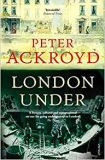London Under by Peter Ackroyd
| London Under by Peter Ackroyd | |
|
| |
| Category: History | |
| Reviewer: John Van der Kiste | |
| Summary: A concise account of London underneath the surface, exploring the world of its springs, streams, sewers, tunnels and above all the Underground railway system. | |
| Buy? Yes | Borrow? Yes |
| Pages: 202 | Date: April 2012 |
| Publisher: Vintage | |
| ISBN: 9780099287377 | |
|
| |
Peter Ackroyd is already well-known as a historian of London. As a kind of adjunct to his mammoth work on the city, here we have a comparatively slender tome on one specific aspect. Underneath the city is a world of its own, of springs, streams, Roman amphitheatres, Victorian sewers, gang hideouts, the creatures which have dwelt in its darkness from rats and eels to monsters and hosts, and last but not least the modern Underground railway system.
In the first chapter, he introduces the strange twilight world of darkness long associated with anything subterranean. The lower depths of anywhere, from ancient cultures to the present, have always been connected with superstition and legend. Classical writers such as Plato and Homer described the underground worlds as places of dream and hallucination. Only a few thousand years ago, the wandering people of Europe lived in or beside the entrances to caves.
All these have their parallels in London, past and present. Throughout the centuries, a fair proportion of London has consisted of underground chambers and tunnels, with extensive catacombs in Camden Town, and prehistoric tunnels under Greenwich Park. In the eighteenth century, a German traveller noted that one-third of the people of London lived underground, or to be precise, that the poor resided in the basements or cellar dwellings that were then part of everyday life for many, while vagrants lived under bridges and arches.
This may be the case no longer. Nevertheless, since the nineteenth century, London underground has again become a way of life for many. A fair proportion of the book examines the waterways and tunnels below the surface. Most familiar of all is the underground railway system itself, opened in 1864 and regularly expanded ever since. When the system was first proposed, a popular preacher declared that it could never last; it would hasten the forthcoming end of the world, as the construction of a subterranean railway burrowing into the infernal regions would disturb the devil. Though such predictions of doom and gloom were not immediately realized, it was feared that passengers might panic at the sight of the walls of the tunnel rushing past them. For years the carriages did not have windows, only tiny slits placed high on the sides. However it was not all bad. When the Central Line was inaugurated in 1900, it was known as the 'Twopenny Tube' because of the flat price of the tickets. Compare that with the Zone 1 off-peak travelcard for which I paid £7 on a recent weekend in town. Meanwhile, some workmen suffered from ill-effects such as 'the bends' while engaged in excavating the tunnels, but for other people the atmosphere was beneficial. A case was reported of an anorexic who suddenly developed a ravenous appetite after a single journey on the tube, said to be connected with the temperature of the tunnels.
During the wars, the underground was seen as a haven, safe from attacks by Zeppelin airships during the 1914-18 conflict and from the worst effects of the blitz a quarter of a century later. At the height of the former, in February 1918, it was estimated that a third of a million people were sheltering there. Two decades later, people would go there with deckchairs, rugs, umbrellas (a strange object to bring into a tunnel, one might think), and enough food to last a fortnight. Soon the platforms were unbearably crowded, many people would have to go to the surface for a few minutes for fresh air, and there were frequent plagues of mosquitoes, but still people stayed in their thousands. Needless to say, the underground was not totally free from enemy attacks from the air, and there were large numbers of casualties in a few distressing episodes.
Unlike Ackroyd’s fuller account of London, this is a very brief book, possible to read in one or two sittings. Beside its godfather, it might seem like a curiously short, possibly even superficial work, perhaps little more than a stepping stone to more detailed volumes. Yet it focuses well and concisely on its subject, and conveys something of the strangely artificial world of pagan temples and bunkers, the safety of being hidden below the surface, the superstitions such a life gave rise to, the labyrinthine network of pipes and tunnels, ditches and streams, another city below the surface city, or a world beneath the world. I found it an interesting look at the almost surreal existence beneath.
Our thanks to Vintage for sending Bookbag a copy for review.
If this book appeals then you might also enjoy:
London: The Concise Biography by Peter Ackroyd
London: The Illustrated History by Cathy Ross and John Clark
Please share on: ![]() Facebook,
Facebook, ![]() Twitter and
Twitter and
![]() Instagram
Instagram
![]() You can read more book reviews or buy London Under by Peter Ackroyd at Amazon.co.uk Amazon currently charges £2.99 for standard delivery for orders under £20, over which delivery is free.
You can read more book reviews or buy London Under by Peter Ackroyd at Amazon.co.uk Amazon currently charges £2.99 for standard delivery for orders under £20, over which delivery is free.
![]() You can read more book reviews or buy London Under by Peter Ackroyd at Amazon.com.
You can read more book reviews or buy London Under by Peter Ackroyd at Amazon.com.
Comments
Like to comment on this review?
Just send us an email and we'll put the best up on the site.


